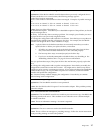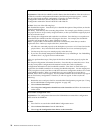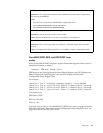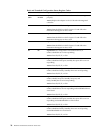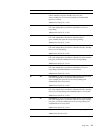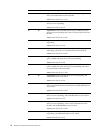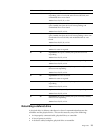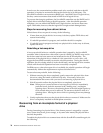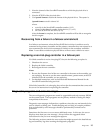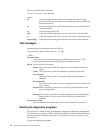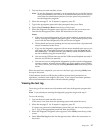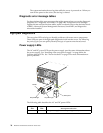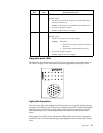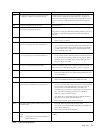24 Hardware Maintenance Manual: xSeries 250
In each case, the communication problem needs to be resolved, and then a rebuild
operation is required to reconstruct the data for the device in its disk array. The
ServeRAID controllers can reconstruct RAID level-1 and RAID level-5 logical drives,
but they cannot reconstruct data stored in RAID level-0 logical drives.
To prevent data-integrity problems, the ServeRAID controllers sets the RAID level-0
logical drives to blocked during a rebuild operation. After the rebuild operation
completes, you can unblock the RAID level-0 logical drives, and access them once
again. Remember, however, that the logical drive might contain damaged data.
Steps for recovering from defunct drives
If the defunct drives are part of an array, do the following:
• If more than one physical drive in an array is defunct, replace DDD drives and
restore from backup.
• If a rebuild operation is in progress, wait until the rebuild is complete.
• If a rebuild is not in progress and only one physical drive in the array is defunct,
replace the drive.
Rebuilding a hot-swap drive
A hot-swap rebuild refers to a rebuild operation that is started by the ServeRAID
controller when it detects that a drive that is part of a RAID-I or RAID-J array and in
the defunct state has been removed and reinserted on the SCSI backplane. The
reinsertion of the physical drive, whether it is the same drive or a new drive, will
trigger the ServeRAID controller to start the rebuild operation. During the rebuild
operation, the drive being rebuilt is in the rebuild state, and the logical drive remains
critical until the rebuild operation has been successfully completed.
On IBM servers, when a hot-spare drive is available, the rebuild operation will begin
automatically without the requirement to replace the failed drive.
To start a hot-swap rebuild, do the following:
1. Without removing the drive completely, gently remove the physical drive from
the server, using the handle of the hot-swap tray. If necessary, refer to the
documentation that comes with your server on removing a physical drive.
2. Wait 20 seconds to allow the physical drive to completely spin down.
Note: When power is removed from a hot-swap drive, the drive immediately
parks the heads, locks the actuator in the "landing zone", and begins
spinning down. However, the spinning down of the disk might require up
to 20 seconds after power is removed. Do not move the drive while it is
spinning down. Moving the drive while it is spinning down may damage
the drive.
3. Gently replace into the server the physical drive that you removed. Make sure the
drive is completely installed in the backplane connector.
Recovering from an incomplete format of a physical
drive
During formatting of a physical drive, if the format process is stopped by a system
reset, system shut down, power outage, or by some other means, the physical drive
becomes inoperable.
To enable the physical drive to communicate with the ServeRAID controller again, do
the following:




